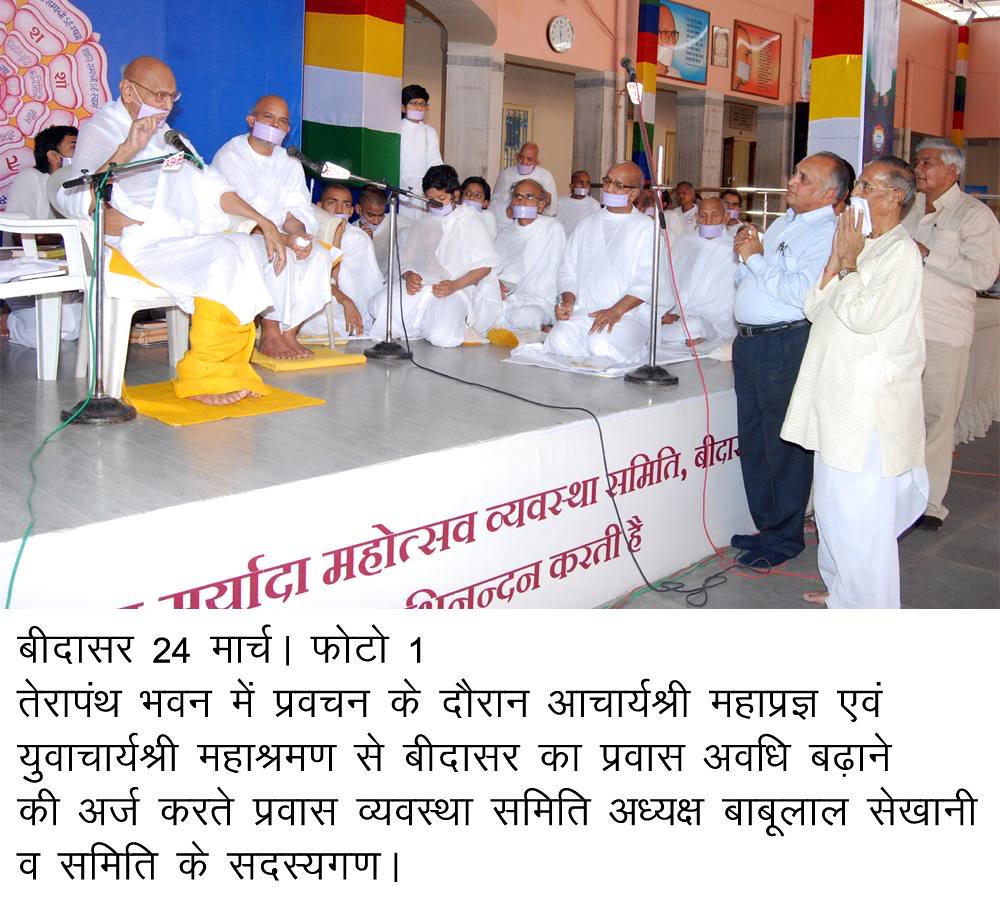JAIN VISHVA BHARATI UNIVERSITY

Special On The 60th Foundation Day Of The Sanstha
 Acharya Mahapragya Pravas Samiti 's president Shri Babulal Sekhani along with his team requesting Acharya Shri to extend his Bidasar stayThe philosophy of Lord Mahavīra is the philosophy of soul. He said, "Soul exists, it is eternal, it is the doer of it's karmas, it is enjoyer of it's karmas, karmas can be got rid of, get rid of all karmas is salvation." One who has faith in and believes this philosophy is known as right faithed. Right-faith is the first step to the way to salvation. Karmas are mixed with soul as sugar candy is mixed with milk. Karmic bondage is related to passions and yoga. On the weakening of the infinite-bonding passion, one attains right faith and on the weakening of the partial renunciation obscuring passion, one attains the fifth stage of gunasthāna i.e. partial abstinence. Jain philosophy believes in the combination of both matter and cause in the occurrence of an event. Subsidence-cum-destruction is the principal exertion of soul. For the appearance of this subsidence-cum-destruction a good cause is required. The desire for salvation is the objective of soul. For letting this desire appear, Parmarthik Shikshan Sanstha acts as a good cause. This is the first step to sanyāsa. This is the chemical laboratory in which the feelings of salvation seekers get purified by various chemical reactions. This is the mother who feeds the salvation seekers with the feelings of renunciation and detachment. This is a factory that cuts the rough stones (the salvation seekers) into beautiful statues (as monks and nuns). This is the laboratory where passions are subsided and yoga is brought to cessation. In Parmarthik Shikshan Sanstha, a salvation seeker is taught every moment -
Acharya Mahapragya Pravas Samiti 's president Shri Babulal Sekhani along with his team requesting Acharya Shri to extend his Bidasar stayThe philosophy of Lord Mahavīra is the philosophy of soul. He said, "Soul exists, it is eternal, it is the doer of it's karmas, it is enjoyer of it's karmas, karmas can be got rid of, get rid of all karmas is salvation." One who has faith in and believes this philosophy is known as right faithed. Right-faith is the first step to the way to salvation. Karmas are mixed with soul as sugar candy is mixed with milk. Karmic bondage is related to passions and yoga. On the weakening of the infinite-bonding passion, one attains right faith and on the weakening of the partial renunciation obscuring passion, one attains the fifth stage of gunasthāna i.e. partial abstinence. Jain philosophy believes in the combination of both matter and cause in the occurrence of an event. Subsidence-cum-destruction is the principal exertion of soul. For the appearance of this subsidence-cum-destruction a good cause is required. The desire for salvation is the objective of soul. For letting this desire appear, Parmarthik Shikshan Sanstha acts as a good cause. This is the first step to sanyāsa. This is the chemical laboratory in which the feelings of salvation seekers get purified by various chemical reactions. This is the mother who feeds the salvation seekers with the feelings of renunciation and detachment. This is a factory that cuts the rough stones (the salvation seekers) into beautiful statues (as monks and nuns). This is the laboratory where passions are subsided and yoga is brought to cessation. In Parmarthik Shikshan Sanstha, a salvation seeker is taught every moment -
jayam care joyam cithhe, jayam māse jayam saye,
jayam bhujanto bhāsamto, pāva kammam na bandhaī.
There is no bondage of demerit if one moves with care, stops with care, sits with care, sleeps with care, takes food with care and speaks with care. In this institution, the salvation seekers are taught - nānassa sāramāyāro - conduct is the essence of knowledge. Hence a salvation seeker should practice both knowledge and activity (theory and practice). Conduct is incomplete without knowledge and knowledge is meaningless without conduct. The salvation seekers here are thoroughly taught the nine basic lessons of Jain learning, six substances and six types of sentinent beings.
This institution is a medium that transforms the salvation seeker, an ordinary pebble into the grand idol of Lord Śiva. Through various experiments, the devotee is taught how to maintain physical, mental and emotional health. The message - samyamah khalu jivanam - restraint is life is sent to the core of a salvation seeker's heart. He/she is taught to be restrained in mind, body and speech. He/she has to follow the code of conduct prescribed for salvation seekers, and to practice humility, adjustment, detachment, bearing pain and subsidence of passions. Living in this institution, the salvation seeker develops group consciousness. It can be said to be the nursery for the formation of habits required for a monk or a nun. Nowhere in the world will we find such a unique research center that provides such excellent teaching and training to salvation seekers.
Ācārya Tulsi, when he was a monk, told his guru Ācārya Kālugani that there was no provision for the education of the nuns in their religious order. He said that education is the demand and necessity of the modern age. Reverend Kālugani, the eighth Ācārya, inspired yuvācārya Tulsi in his last instruction to make proper arrangement for the education of nuns. This instruction touched the heart of muni Tulsi deeply. When he became the Ācārya, he founded Parmarthik Shikshan Sanstha on the second day of the month of Falguna śukla in vikrama samvata 2005, on the occasion of the birth anniversary of his guru to repay his debt. It was such a swāti nakshatra (15th of the twenty seven constellations) that the drop of the education of nuns fell into the shell of the fertile mind of Ācārya Tulsi and gave birth to the pearl of Parmarthik Shikshana Sanstha. On that auspicious day, Ācārya Tulsi founded three institutions together - Parmarthik Shikshana Sanstha, Anuvrata and Ādarśa Sāhitya Sangha. Blessed is Ācārya Tulsi blessed is his intellect. We bow to his transcendental consciousness.
Mankind will remember forever - Ācārya Tulsi, the founder of this institute for his extra-ordinary fore-sightedness and intellect. In the words of Ācārya Mahapragya, "Parmarthik Shikshan Sanstha is an everlasting storage of salvation seekers. This is not only a gold mine, but also a mine of diamonds. It has made, is making and will continue making its contribution to society. According to the great scholar, great monk Yuvācārya Mahāshraman, this is an original institute; it has trained a large number of people and qualified them to be included in the category of monks and runs. Kanakaprabhāji, the affectionate and loving, head of nuns of the religious order had described this institution as the institution providing the education of knowledge, philosophy and conduct, fulfilling the demands of the age. Nun Vishrutvibhāji, the Chief Niyojikā finds this institution a sacrament forming institution, besides providing education.
This institution forms spiritual-scientific personality. Spirituality helps us in knowing ourselves whereas science gives us the knowledge of creation. Spiritual scientific personality means the combination of reality and practical point view. Ācārya Mahāpragyaji says, "Exist within yourself, live outside." To live happily within spirituality is necessary. To live happily outside, we resort to science. The co-ordination of spiritualism and science is the theory of manifold predications. This institute is run on the principles of manifold predications, relativity and the doctrine of qualified assertions. Here the salvation seekers are taught to know truth from various angles and points of view. Truth has no limit but speech has its limitations. Speech can express only a few modes of truth. Absolute truth cannot be expressed by speech. It can be known only by experience and feeling. This institute inspires the inmates to know truth and non-violence and to live a life of fearlessness. According to the theory of manifold predications, many contradictory natures may be found in one thing. When many contradictory natures can exist in one object, why cannot people of contradictory natures and having different views live together? Parmarthik Shikshan Sanstha teaches to live community life. The main slogan of the institute is - ahimsā paramo dharmah, aparigraha paramo dharmah : All the salvation seekers dwelling in the institute observe the principles of non-violence and non-possession. Practicing partial non-violence, a salvation seeker becomes totally non-violent, by the time he/she is initiated. The life-style of all the salvation seekers is very simple, and pertains to non-violence. "ahimsā savvabhāya khemankari" - Non-violence benefits each and every being. Non-violence is the mother of all the Indian philosophies. It is the essence, gist of all spirituality. Not to trouble any being in the least through mind, body and speech, not to let others inflict pain on beings and to not even second causing pain to others - this important training is imparted in this prestigious institute.
This maxim is written on the main gate of most of the educational institutions - jñānārtha praveśa sevārtha prashthāna - enter, to gain knowledge; exit, to serve others. A salvation seeker enters Parmarthik Shikshan Sanstha to develop his/her spiritual faculty and exits to spread spirituality all over the world. Having practiced devotion and the knowledge of self in this institute, a salvation seeker proceeds to the path of 'tinnānam tārayānam (to achieve self pleasure and let others to get pleasure). He/she dedicates himself/herself to the welfare of self and others. Today, the whole world is suffering from anarchy, violence, tension, insensitivity, corruption, immorality, intolerance and indiscipline. At such a critical time, a salvation seeker, trained in this institute, comes out to the world as a monk, or nun and as an ideal. Influenced by the ideal of the monk, or nun the masses undergo a change of heart and come to adopt non-violence, friendship, fearlessness, morality, compassion, tolerance, authenticity, discipline, sensitivity and peace. That is why there is a condition of balance in the world; otherwise there would have been a complete deterioration of human values. Sanyāsīs make the atmosphere of the world peaceful and pleasant, as their thinking is positive.
Parmarthik Shikshan Sanstha believes in the Jain theory of 'shatjīvanikāya' (the existence of six kinds of life). According to Jain philosophy, all the six elements of environment - earth, water, fire, air, vegetation and minute beings - are living beings as we are. They have the same souls as we have. They too have the instincts of food, fear, sexual intercourse and possession. They too feel joy and sorrow. They too have the feelings of lovability and non-lovability. Hence, exploiting environment more than required is unnecessary violence. None of the salvation seekers dwelling in this institute never commit unnecessary violence on these beings; they observe restraint. This institute draws a dividing line between world and sanyāsa. A salvation seeker moves from attachment to detachment. The future of the religious order of Terāpantha is moulded in this institute. The future of Terāpantha lies in the white army that is formed here. Parmarthik Shikshan Sanstha may be said to be the three-fold river of purity, equanimity and restraint. These three elements - purity, equanimity and restraint can be defined as detachment, joy and peace. These three elements - detachment, joy and peace - are the symbols of white aura, yellow aura and red aura. These auras purify feelings. On the basis of all these things it can be said that Parmarthik Shikshan Sanstha is the institute on observing devotion where, feelings are purified.
Parmarthik Shikshan Sanstha is the heritage of the whole humanity that prepares sanyāsīs. Sanyāsīs are members of the world community as they believe in the maxim "Vasudhaiva kutumbakam" - The whole world is one family. They belong to the whole world. They spread non-violence, peace, truth and love throughout the world. They protect human values, inspire people to be good persons and also train them by different experiments. We bow and pay our respect to such a holy and useful institute, that produces such sanyāsīs.
 Prof. Dr. Sohan Raj Tater
Prof. Dr. Sohan Raj Tater